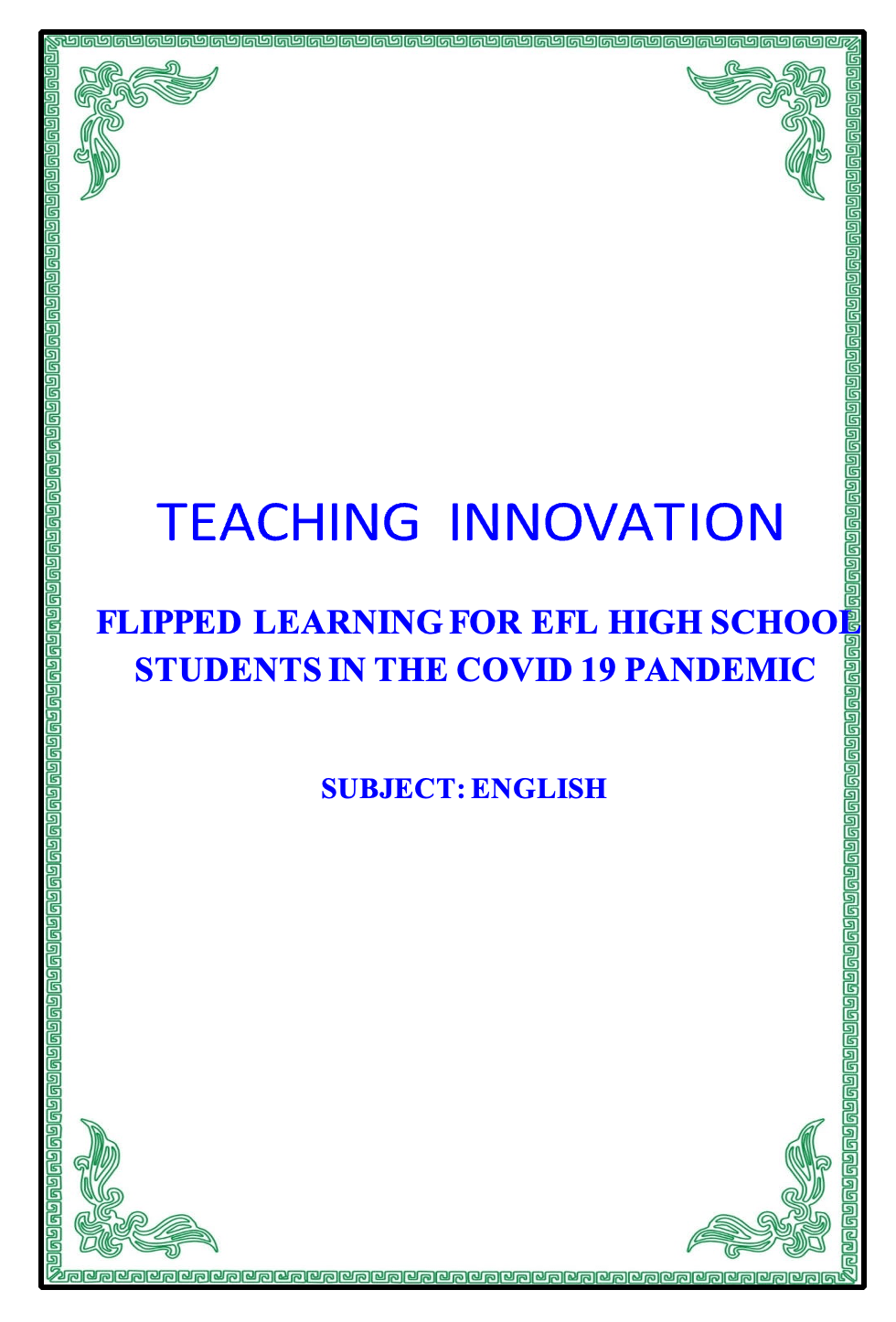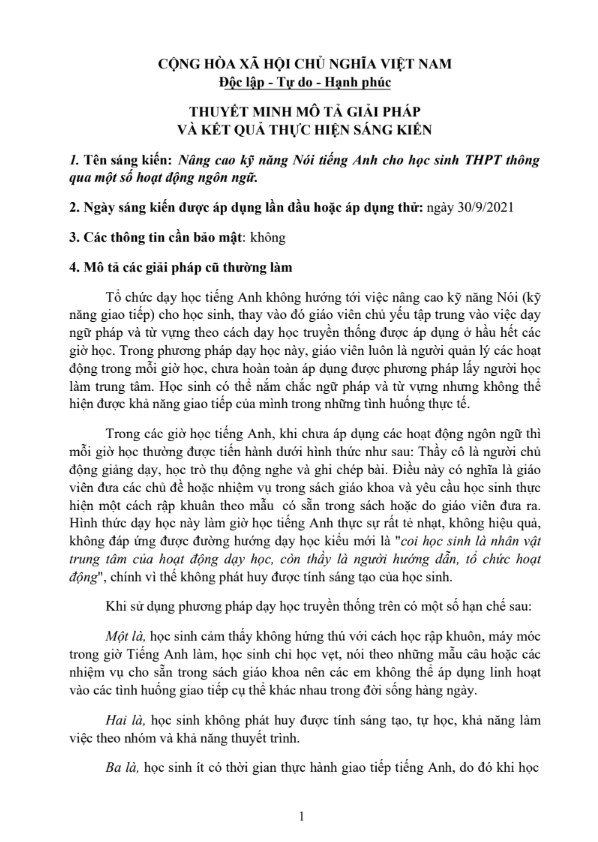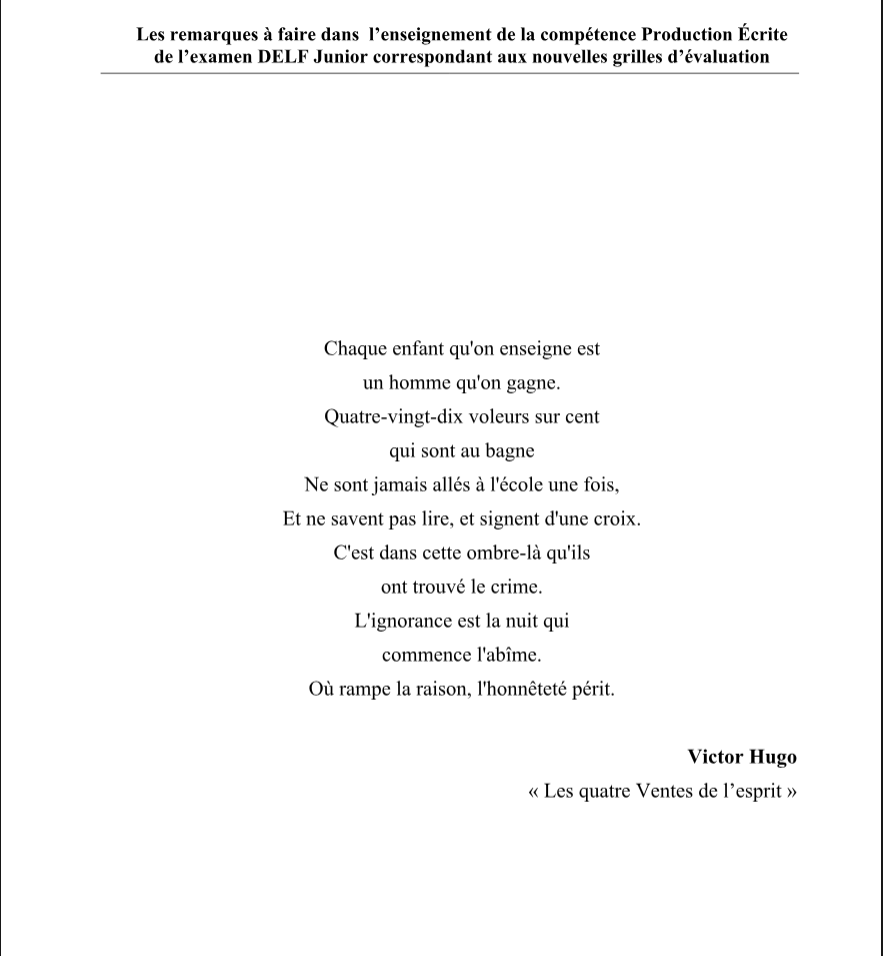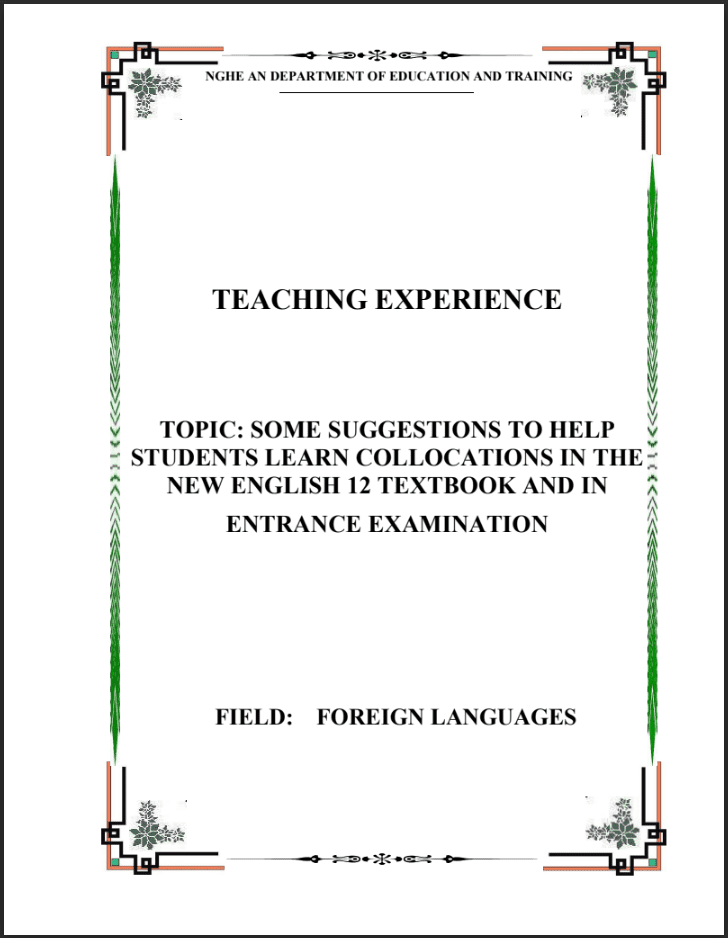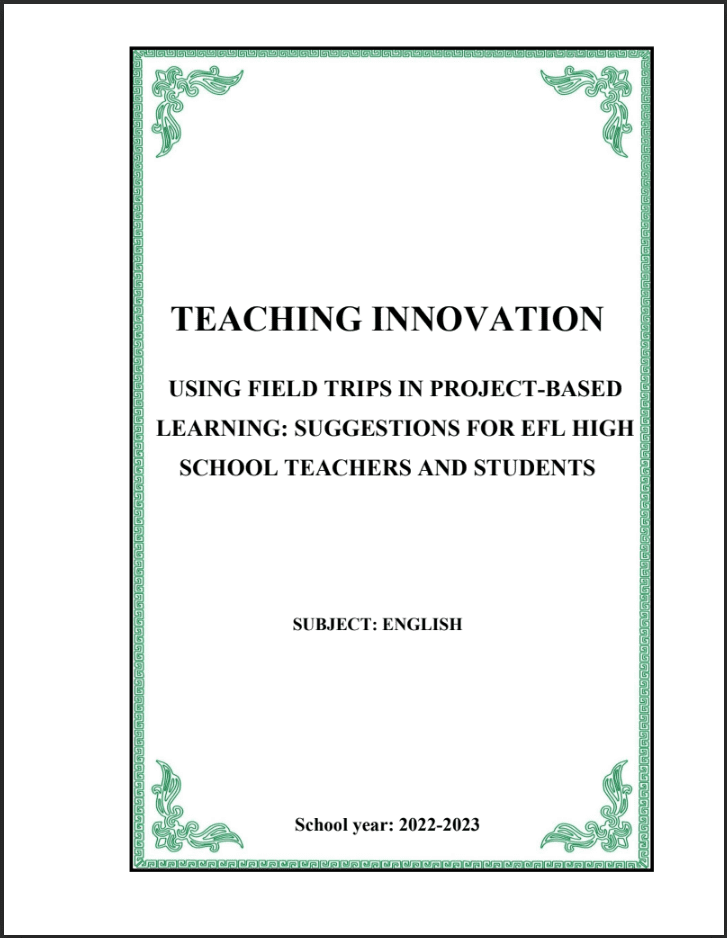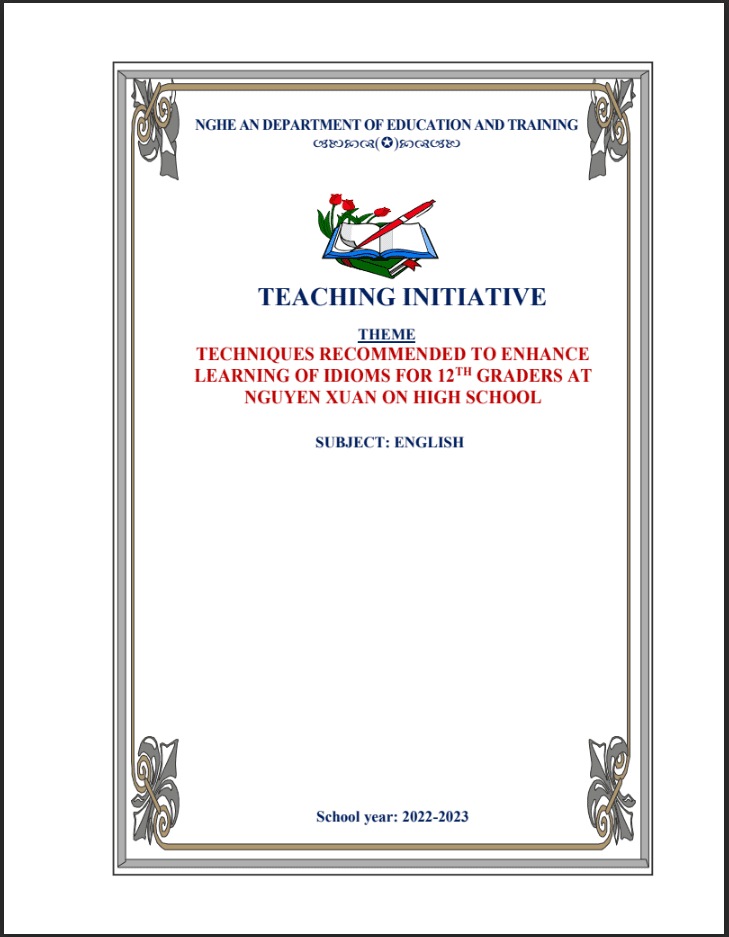SKKN Flipped Learning for EFL High School Students in the Covid 19 Pandemic
- Mã tài liệu: MP0028 Copy
| Môn: | Tiếng anh |
| Lớp: | 10, 11 |
| Bộ sách: | |
| Lượt xem: | 603 |
| Lượt tải: | 4 |
| Số trang: | 38 |
| Tác giả: | Đặng Thị Diệu |
| Trình độ chuyên môn: | Cử nhân đại học |
| Đơn vị công tác: | THPT Nguyễn Đức Mậu |
| Năm viết: | 2021-2022 |
| Số trang: | 38 |
| Tác giả: | Đặng Thị Diệu |
| Trình độ chuyên môn: | Cử nhân đại học |
| Đơn vị công tác: | THPT Nguyễn Đức Mậu |
| Năm viết: | 2021-2022 |
Sáng kiến kinh nghiệm “SKKN Flipped Learning for EFL High School Students in the Covid 19 Pandemic” triển khai gồm các biện pháp nổi bật sau:
– give students opportunities to engage in meaningful activities without the teacher being central.
– scaffold these activities and make them accessible to all students through differentiation and feedback.
– establish spaces and time frames that permit students to interact and reflect on their learning as needed
– continually observe and monitor students to make adjustments as appropriate
– make myself available to all students for individual, small group, and class feedback in real time as needed
Mô tả sản phẩm
PART 1: INTRODUCTION
1.1. Rationale
Due to the outbreak of Covid 19 pandemic, to shut down worldwide. The closure of education institutions disrupted the educational process and most schools and universities shifted towards online learning. To cope with this problem, many educational institutions apply effective methods to resume the teaching and learning process. One of the approaches is flipped learning which aims to engage students inside and outside the classroom. According to Lockwood (2014), the flipped learning approach depends on presenting the materials through pre-class input like recorded video lessons. It also provides students more time to practice their language in the classroom because students have to go to the classroom to do some exercises and activities. Brown (2007) states that flipped learning is used to save the classroom’s time for discussion and providing plenty of materials covering the same topic. Besides, it is effective since it supplies immediate feedback which increases the learner’s comprehension of the provided content. Bergmann and Sam (2021) have mentioned that flipped learning allows students to study individually and they can learn and revise the materials anytime and anywhere they want. In the same perspective, Lockwood (2014) believes that flipped learning develops students’ high thinking skills like synthesizing, application, and evaluation. It is true that during the time of Covid 19, flipped learning is considered as part of blended learning in the classroom. It is basically a pedagogical model which reserves classroom activities. Materials or contents are provided online (in learning management system or other learning platforms) and students will study the material prior coming to class. Therefore, classroom time can be used to engage in activities such as problem solving, discussion and analysis. This study aims at exploring the effects of flipped learning approach in classroom by suggesting process of flipped learning through lessons for learners at upper secondary schools and the students’ perceptions on its effectiveness and feasibility. The matter of fact I mentioned above inspired me to choose the topic “Flipped Learning for EFL High School Students in the Covid 19 Pandemic”. Hopefully with the suggested techniques and tools, teachers can use them as a source of reference in their teaching process.
1.2. Aims of the study
The aims of the study are as follows:
- To provide a brief review of flipped learning used to teach students in English lessons during the time of Covid 19.
- To suggest stages of flipped learning used in lessons
- To explore the perception of teachers and learners to this approach in practice
1.3. Scope of the study
The study pays a focus on the techniques and tools which are used for flipped learning at upper secondary level. Therefore, the study is conducted on the subject of teachers and learners coming from some high schools in Vinh city. The innovation of this study is that flipped classroom is beneficial to be applied in the language classroom as it presents more effective active learning, the teacher role is strengthened, time is used more efficiently and more interactively, peer learning is enhanced, greater control of content delivery, assimilation of knowledge can be observed and students can learn on demand. In addition, this approach seems to show its prominence for teaching in the time of pandemic and soon becomes a better alternative in language classroom.
1.4. Organization of the study
The study will consist of the following parts:
Part 1: Introduction
This part consists of the rationale, aims, scope, and organization of the study.
Part 2: Content
This part mentions the theoretical background of the topic with an overview flipped learning. It also suggests some techniques and tools used in English lessons to evaluate students’ demonstration of skills and knowledge, their performance and products as well as their attitude during learning process. The application of these techniques and tools is on the scale of units for students at high school. Additionally, the perception of teachers and learners to this approach will be discussed and identified.
This part also shows a demonstration of flipped learning process in some periods of English lessons. The data collected from the study will be discussed more in detail in this part.
Part 3: Conclusion
In order to convey an overall conclusion of the study, Conclusion reviews the main findings of the study. As for the implication of the study, some suggestions are recommended to contribute to the success of assessing students’ outcomes.
PART 2: CONTENT
2.1. Theoretical Background
2.1.1. Flipped Learning
The origin of flipped learning comes from Jonathan Bergmann and Aaron Sam who created flipped learning by reserving the classroom lecturing and explanation of the topics included in the course material with activities and interactive tasks to be done in the classroom. According to them, the theoretical material will be studied by the students individually through recorded classes or videos while the class time is devoted to doing exercises and task relevant to the theoretical topics (Bergmann & Sam, 2012). In the same view, Khan and Oiriddine Abdou (2020:2) offered a modified model of the flipped learning approach to continue the educational process during COVID-19 pandemic which enables educators to share the learning materials with their students and encourages students to prepare the lesson and try to comprehend it “prior to the class time and offers teachers the opportunity, during class time, to ensure that every students actively participates in the lesson and deep understanding is acquired”. According to Flipper Learning Network, flipped learning is a pedagogical approach in which direct instruction moves from the group learning space to the individual learning space, and the resulting group space is transformed into a dynamic, interactive learning environment where educator guides students as they apply concepts and engage creatively in the subject matter. Also, Barbara Walvoord and Virginia Johnson Anderson encouraged the use of this approach in their book Effective Grading (1998). They suggest a model in which students gain first-exposure learning prior to class and focus on the processing part of learning (synthesizing, analyzing, problem-solving, etc.) in class. These writers propose an assignmentbased model in which student create work such as writing, problems, etc. in order to ensure that students do the preparation necessary for productive class time. Teachers offer productive feedback through the processing activities that occur during class, reducing the need for the instructor to provide extensive written feedback on the students’ work. Many other authors such as Fitzpatrick, 2012, Berrett (2012), Mazuz (2009) believe that “flipping the classroom” means that students gain first exposure to new material outside of class, usually via reading or lecture videos, and then use class time to do the harder work of assimilating that knowledge, perhaps through problem-solving, discussion, or debates. In term of Bloom’s taxonomy (2001), this means that students do the lower levels of cognitive work (gaining knowledge and comprehension) outside of class, and focus on the higher forms of cognitive work in class such as application, analysis, and/or evaluation. This model seems to be opposite with the traditional model in which “first exposure” occurs via lecture in class, with students assimilating knowledge through homework.
TÀI LIỆU LIÊN QUAN
- 7
- 105
- 1
- [product_views]
- 5
- 173
- 2
- [product_views]
- 4
- 165
- 3
- [product_views]
- 4
- 129
- 4
- [product_views]
100.000 ₫
- 6
- 434
- 5
- [product_views]
100.000 ₫
- 2
- 507
- 6
- [product_views]
100.000 ₫
- 9
- 546
- 7
- [product_views]
100.000 ₫
- 4
- 409
- 8
- [product_views]
100.000 ₫
- 2
- 595
- 9
- [product_views]
100.000 ₫
- 0
- 538
- 10
- [product_views]

